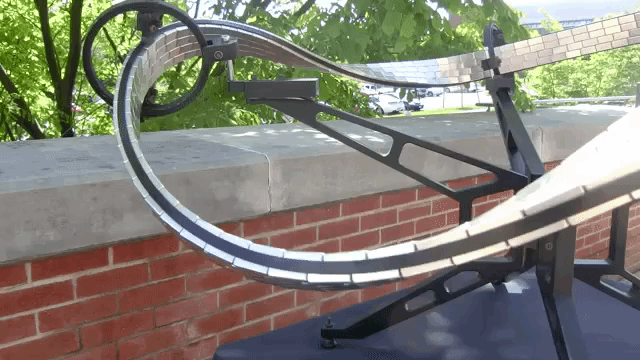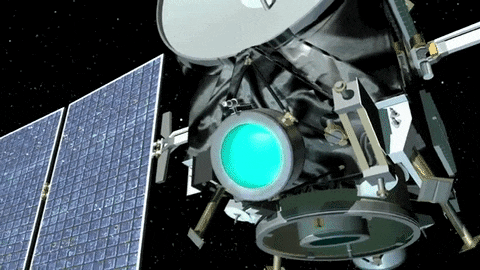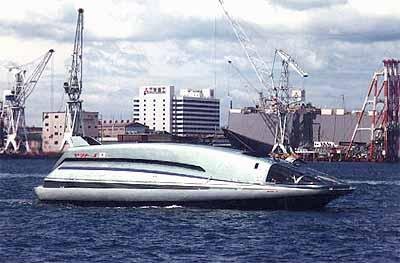Electromagnetic Propulsion | Super Cool Science S#!t #27
What is electromagnetic propulsion?

Superconductor levitating above and below mobius strip by Ithaca College Physics
Put simply, Electromagnetic propulsion is the process of moving an object with electricity and magnetic fields. When you apply an electric current to a conductor while it's in a magnetic field, you can observe what's come to be known as the Lorentz Force, by which the conductor will be propelled along the magnetic field.
We all know that magnets will attract or repel one another based on the orientation of their magnetic fields. Electromagnets produce a magnetic field only when an electric current flows through them, allowing us to switch them on or off at just the right time to create a system where a magnet is pulled and pushed along a chain of electromagnets.
Exploiting both the attractive and repulsive nature of magnets together, you can even force an object to travel upside down along a track!
What can we use electromagnetic propulsion for?
Scientists and engineers are working every day toward realizing the true potential of this incredible phenomenon, and they're already developing revolutionary technologies that will change the future of numerous industries.
Magnetic Levitation (Maglev) Trains

Japanese Maglev bullet train. IMG SourceOne way we're already utilizing electromagnetic propulsion is with Maglev trains.
These trains float on magnets, held stable about four inches above their tracks while another chain of meticulously controlled magnets pushes it along.
Without moving parts like wheels, these trains produce no friction while travelling, which of course lets it move at incredible speeds. For this reason, they're often called "bullet trains". These are the fastest trains in the world, travelling down their tracks at up to a blistering 375 miles per hour! (~600 km/h) This sort of technology could allow passengers to travel from New York City to Los Angeles in just over 9 hours!
Railguns

US Navy railgun penetrating multiple steel plates. IMG SourceAs with any other nice thing we try to have for ourselves, the United States military saw this and was like "Wait... You can push things really fast with magnets? Hold my beer..."
Meet the railgun; A truly devastating weapon that uses the principles of electromagnetic propulsion to launch heavy metal projectiles over five times the speed of sound! The projectile launched does not carry any explosive material, relying instead on pure kinetic energy as it slams into its target at 5000 miles per hour.
I could imagine a weapon system like this being utilized in space where there isn't an oxygen rich atmosphere to properly fire traditional guns...
Space Launches

NASA Maglev launch system test. Credit: NASAInstead of launching a big hunk of pointy metal into an enemy stronghold, what if we used this technology to launch a spaceship into orbit?
Without the need for huge tanks of explosive liquids weighing down our ships and potentially immolating our astronauts, imagine how much cheaper and safer we could make getting into space.
Ion Thruster

Rendering of satellite using an ion thruster. Credit: NASAOnce we've got our ship or satellite in space, we can switch over to a different form of electromagnetic propulsion.
Electromagnetic ion engines propel countless particles to produce thrust in the vacuum of space. The thrust is so miniscule that we could never use these engines to actually get us into orbit, they can provide an ever increasing top speed when there's no friction or gravity to counteract the push from the stream of particles being ejected from the thruster.
Magnetohydrodynamic drive

Yamato-1 MHD ship in Japan. IMG SourceWhat basically looks like a spaceship that crashed landed in the ocean, the Yamato-1 was the first full size working prototype using the principles of electromagnetic propulsion in water instead of air.
By using magnets to control the flow of a conductive fluid like seawater, the MHD pulls water in the front, pushing it through and out the rear which propels the ship through the water. It's not an incredibly efficient means of propulsion as seawater can only conduct so much electricity and our electromagnets are only so powerful, but it proves that you can apply the Lorentz force to travel through any medium which you can conduct electricity.
Electromagnetic Propulsion is super cool!
I believe we've only begun to scratch the surface of what this sort of technology can do when we full understand the science behind superconductivity and electromagnetism. I can't wait to see what the future holds and what sort of new wonders the scientists of the world will be able to discover when pushing the limits of propelling objects with magnets.
References:
- https://science.howstuffworks.com/electromagnetic-propulsion.htm
- https://en.wikipedia.org/wiki/Lorentz_force
- https://www.nasa.gov/feature/glenn/2020/the-propulsion-we-re-supplying-it-s-electrifying
- https://www.baltimoresun.com/maryland/bs-md-japan-maglev-20180531-htmlstory.html
- https://www.wired.com/story/the-magnetohydrodynamic-drive-is-realand-you-can-build-one/
- https://www.longdom.org/open-access/a-review-on-electromagnetic-propulsion-by-stimulated-forces-53822.html
- https://en.wikipedia.org/wiki/Electromagnetic_propulsion
- https://science.howstuffworks.com/rail-gun1.htm
- https://aip.scitation.org/doi/abs/10.1063/1.1290978?journalCode=apc
- https://www.nasa.gov/centers/glenn/about/fs21grc.html
Thank you so much for reading!
If you enjoyed this post and learned something new, consider throwing me an upvote or even sharing it with your followers. You can also visit this Curated Collection to catch up on the rest of the series.



This technology have a real potential because of various use cases.
Rails based on this technology are already in action and gaining good popularity as well.
Let's see where else this can be used.
!LUV 1
Sorry, you're out of LUV tokens to be sent today. Try tomorrow. (Having at least 10 LUV in your wallet allows you to freely give 3 per day.)